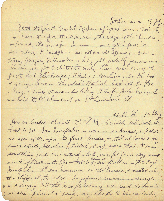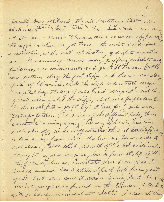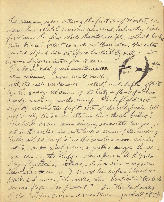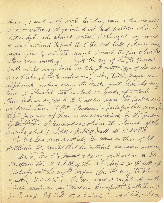Hall Id. -- 14th J.
Here we landed at about 7:30P.M. + hunted till dark, at about 11.30. Saw Snowflakes as soon as we landed, + I shot one soon after, up on the first tundra, + tho't it looked very fine + white, but when I picked it up, saw that it something quite new, entirely white except for a very small amount of black on the tips + tertials, + central tail feathers -- McKay's Snowflake. It was common on the tundra, + nested along the cliffs at the edge. Longspurs were common enough, and singing but the snowflake's song was easily the finest, a clear "prismatic" song, very like the W. Meadowlarks, [Page 51] possibly more deliberate, tho not hesitating. Kleener tee-Klink-atse Plew Klinc Tsew - (do) [with Illus]. Sea-birds were numerous out at sea + seemed to become more so as we approached the cliffs -- + when we got there -- the most wonderful + interesting, as the most exhilarating of sights awaited us. Thousands of Murres, many puffins, auklets and fulmars, also cormorants and great Pt Barrow Gulls were nesting along the great cliffs and the air was always full of them all, while the cliffs had actually every horizontal ledge the size of one's hand occupied -- and this great colony filled the cliffs, which were perpendicular for the most part, + 300 ft high at least, for 1/2 mile, and perhaps farther. The noises of the different birds, their constant coming and going, turning of heads, pushing each other off, made a spectacle that it was difficult to tear away from when the limited time made it necessary to see what the rest of the Id. contained. I caught a murre in my hands from the top of the cliff, + Coe did likewise. Leucosticte were seen + as I turned inland I saw what I first took for a great qull, but soon saw it was a Snowy Owl. A nest with 4 young was found on the tundra, + Mr D. got a nearly immaculate adult. I chased this [Page 52]one I saw for an hour + a half, till darkness and fog came on at 10:30; It was the most alert bird I ever hunted, + I couldn't show the barest inch of myself above the rock or draw I was taking advantage of without his seeing me, + quietly taking flight, to alight a small spot on the next Mt. Shoulder - without a sign of tree nor shelter to approach behind - four times I crawled after him, first crouching behind a low rise in the ground, then on hands + knees around to a low stone, then on my stomach for 100 yds up a swampy rill a foot or two lower than the surrounding land -- to have him see a shoulder or the top of my cap -- + away he would fly -- only once, the first time - did I get a chance to shoot, + that was when he rose. I just saw the top of his white head almost 60 yards away when he saw me + rose, + I blazed at him without effect, didn't pull the trigger hard enough, as Ridgeway says.
Had an exciting tho fruitless climb after a snowflake wh. fell over the shaly edge of the tundra, + a more risky one after a fulmar I shot. I got frightened, tho, by the open gulf below + the crumbly character of the lava + when I had once gotten over the edge + partway [Page 53] down, + sent a big rock hurtling down a hundred feet or so, + watched it go into dust and pebbles when it hit a dike wh. showed below, I changed my mind + was relieved to find that the sod held + I was once more firmly on top, turned toward the fire where the others were waiting. I got the egg of the Pt. Barrow Gull on the way back -- + Cole got nest + Eggs of the new Snowflake (hitherto unknown) Long tailed Jaegers were apparently roosting along the beach, just above the surf line. I flushed two in about 100 yards, after dark. These birds are supposed to be nesting up in the tundra when we found them at Pt. Clarence + perhaps they were, but their presence up there is also explained by the finding of Dr. Coe, of two meadow voles in the stomach of the one he shot! I shot a Pribiloff Sandp. at 10:25P.M.
The birds here were practically the same as those of St. Matthews Id. except that the water birds were more numerous.

[page 50 Continued]

[page 51]

[page 52]

[page 53]